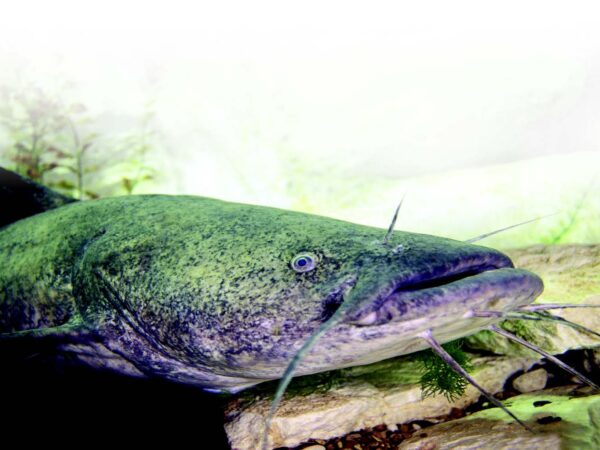
Flathead Catfish
(Pylodictis olivaris)
Species at a Glance
The Flathead Catfish is at the top of many “least wanted” invasive species lists because of its large size, carnivorous feeding habits, large size, long life span, adaptability, and ability to swim long distances in a short time. It has been widely introduced into Atlantic Slope drainages and is impacting ecosystems in the eastern portion of Pennsylvania as well as the Great Lakes.
Species Description
As the name suggests, the Flathead Catfish is most easily recognized by its broad flat head and lower jaw, which projects beyond the upper jaw. The Flathead Catfish also has a distinctive tail fin outline that is square or slightly notched. It can grow up to 152 cm (60 in) long and weigh on average 30 lbs., although some have been known to reach over 100 lbs. While the coloration can vary, most adults have an olive-colored back and sides with dark brown to yellow-brown mottling. The belly is yellowish-white, and the eyes are relatively small. Young Flathead Catfish are nearly black on their backs.
Native & Introduced Ranges
The Flathead Catfish is native to the Rio Grande and Gulf Slope drainages and the Mississippi River basin, including the Ohio River drainage in western Pennsylvania. The first report of the Flathead Catfish in the Delaware River basin was from Blue Marsh Reservoir (Schuylkill River) in 1997. Since then, introduced Flathead Catfish have spread throughout regions of the Delaware, Schuylkill, and Susquehanna rivers.
Biology & Spread
Unlike other catfish, the Flathead Catfish is an obligate carnivore and preys primarily on live fish. However, a diet study in the Susquehanna River Basin revealed that they also fed on crayfish. Male Flathead Catfish actively guard nest cavities and show aggression toward other fish. Today the main source of introduction of the Flathead Catfish is from intentional release by anglers.
Habitat
The Flathead Catfish thrives in reservoirs, lakes, rivers, and large streams. It prefers deep, sluggish pools with logs and submerged cover to use as shelters. Young Flathead Catfish live in rocky or sandy river runs and riffles.
Impacts
Threat to biodiversity
Introductions of the Flathead Catfish in other states have resulted in large declines of native fish populations. In the Altamaha River in Georgia, the Flathead Catfish eliminated Bullhead Catfish and caused an 80 percent reduction in Redbreast Sunfish numbers. In coastal North Carolina rivers, the Flathead Catfish has eliminated native catfish populations and was found to prey heavily on crayfish and shad. There is also concern that the Flathead Catfish may prey heavily on crabs and young American Eels.
Economic costs
Preliminary research suggests that predation by the Flathead Catfish might hinder costly shad, sturgeon, American Eel, and Striped Bass restoration efforts in the Delaware Estuary and Chesapeake Bay tributaries.
Health risks
Like other predacious fish, the Flathead Catfish can accumulate contaminants such as PCBs (polychlorinated biphenyls) in its tissue. For this reason, the Commonwealth of Pennsylvania advises eating no more than one meal a month of Flathead Catfish caught in the lower Schuylkill River and lower Susquehanna River. More tissue testing is needed to determine the safety of eating this fish from other areas.
Prevention & Control
Fishing and electrofishing may provide a way to reduce Flathead Catfish biomass so that native fish populations can survive. However, preventing the introduction and spread of the Flathead Catfish is the best way to protect natural habitats from harm.
- Know how to identify and report the Flathead Catfish.
- Anglers who catch Flatheads in the Delaware and Susquehanna watersheds are encouraged not to release them, regardless of size.
- Always check for and remove plants, mud, and debris from boats, trailers, clothing, and equipment before entering a water body and before leaving a water body.
- Drain all water from bait buckets, bilges, and live wells before transporting to new areas.
- Clean all gear and equipment with hot water (140°F or 40° C) or salt water, OR let boats and equipment dry thoroughly for at least five days before entering a new water body.
- Unused live bait should be disposed of in the trash; it is unlawful in Pennsylvania to release any unused live bait.
References:
- Brown, J. Jed, Joseph Perillo, Thomas J. Kwak and Richard J. Horwitz. 2005 (In review). Implications of the Flathead Catfish, Pylodictis olivaris, Introduction into the Delaware and Susquehanna Drainages.Fuller, Pam. 2004. Pylodictis olivaris.
- USGS Nonindigenous Aquatic Species Database, Gainesville, FL.
- Smith, G. et al. 2018. Analyzing Native and Invasive Flathead Catfish Populations for Species Management. Pennsylvania Sea Grant.



